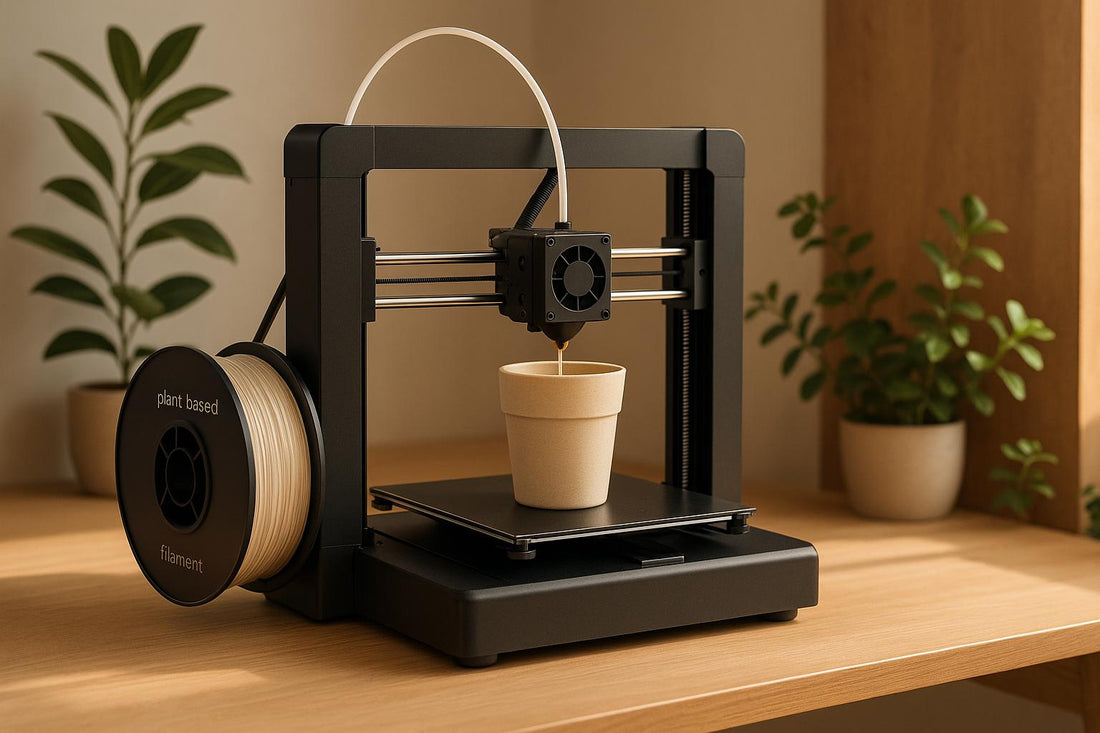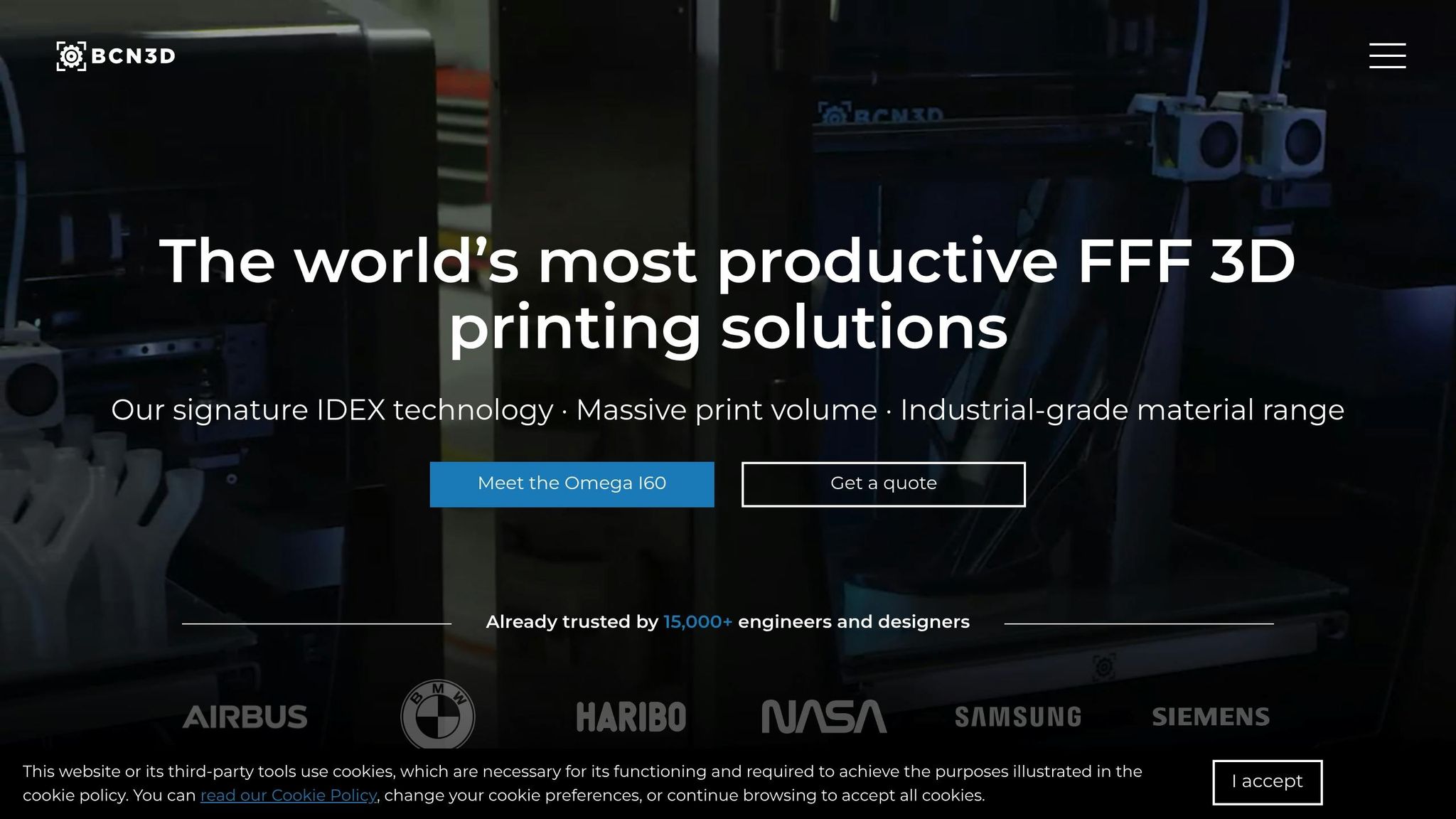
Ultimate Guide To Sustainable 3D Printing
3D printing offers a smarter way to create custom items, but making it eco-friendly takes thoughtful choices. Here's what you need to know:
- Eco-friendly materials like PLA (plant-based), recycled PETG, and ocean plastics reduce waste and pollution.
- Efficient designs minimize material use with hollow interiors, optimized supports, and modular components.
- Energy-saving practices include batch printing, smart printer settings, and using materials with lower printing temperatures.
- Local production cuts transportation emissions, while take-back programs and recyclable materials extend product life.
This guide explains how to make 3D printing better for the planet without sacrificing quality or functionality. Whether you're printing gaming accessories or fidget toys, small changes can make a big difference.
BCN3D Explains: Sustainable 3D printing

Eco-Friendly Materials for 3D Printing
When it comes to sustainable 3D printing, the materials you choose play a big role in balancing performance and environmental responsibility. Using eco-friendly filaments - whether biodegradable, recycled, or recyclable - makes it possible to create durable, resource-conscious gaming accessories and more.
Biodegradable and Plant-Based Filaments
PLA (Polylactic Acid) stands out as one of the most commonly used biodegradable options in 3D printing. Made from renewable resources like corn starch and sugarcane, PLA can break down in industrial composting facilities. It’s easy to work with, thanks to its low printing temperature and strong adhesion, making it perfect for intricate designs like miniatures and dice towers.
However, PLA performs best indoors since it’s not as durable under extreme or outdoor conditions.
Wood-filled filaments combine PLA with wood particles to replicate the look and texture of real wood. This makes them a great choice for decorative gaming pieces that maintain an eco-friendly profile.
Hemp-based filaments mix hemp fibers with biopolymers, resulting in lightweight yet sturdy prints. These are ideal for creating durable gaming components that can withstand regular use.
Recycled and Recyclable Filaments
PETG (Polyethylene Terephthalate Glycol), often made from recycled plastic bottles, offers a combination of strength, durability, and clarity. It’s an excellent choice for functional gaming items like custom dice and tokens. Plus, its recyclability supports efforts toward a circular economy.
Recycled ABS filaments give new life to post-consumer plastics, creating tough, long-lasting materials. These are particularly suited for high-use items like dice towers, though they require higher temperatures during printing.
Ocean plastic filaments turn marine waste into durable 3D printing material. These filaments are a sustainable option for producing gaming accessories or even fidget toys, helping to clean up the environment in the process.
Material Properties and Applications
The properties of each material play a big role in determining its best use. For example, PLA is ideal for intricate designs like gaming miniatures because it has low shrinkage and requires minimal post-processing. Its lower energy requirements also make it a good choice for indoor items. On the other hand, PETG and recycled ABS are better suited for items that need to withstand higher temperatures or greater wear and tear, like functional gaming components.
To maximize sustainability, it’s important to consider the end-of-life options for these materials. PLA can be composted in industrial facilities, while PETG and recycled ABS can be recycled. Choosing materials with clear disposal or recycling paths helps reduce waste and ensures that the entire lifecycle of your 3D-printed products aligns with eco-friendly practices.
Techniques for Waste Reduction in 3D Printing
Cutting down on waste in 3D printing isn't just about picking the right materials. The way you design your product and manage the printing process plays a huge role in minimizing material usage and reducing the overall environmental impact. These methods can help produce high-quality gaming accessories and custom items while keeping the ecological footprint smaller.
Additive Manufacturing vs. Traditional Methods
Unlike traditional subtractive manufacturing, where material is carved away from a solid block, 3D printing uses only the material required to create the object. This approach allows for features like hollow designs and intricate internal details that would be tough - or even impossible - to achieve with older methods. Plus, the precision of modern printers helps reduce errors and waste, meaning fewer reprints. Together, these advantages connect material efficiency with smarter design, promoting sustainability throughout the process.
Smarter Support Structures
Support structures are often necessary in 3D printing, but they can lead to excess material waste. By making smarter design choices, you can significantly reduce this waste. For example, branching support patterns use less material while still providing stability. When supports are unavoidable, using dissolvable materials like PVA or HIPS can make cleanup easier and waste less in the long run. Breakaway supports are another great option - they’re easy to remove and reduce both material use and post-processing time without compromising the finished product’s quality.
Designing for Recycling and Reusability
Beyond reducing material waste, designing with recycling and reusability in mind can extend a product’s lifespan and make it easier to recycle. Modular designs, such as a dice tower with removable trays or swappable decorative panels, make repairs and recycling much simpler. Avoiding permanent adhesives and using snap-fit connections also allows components to be disassembled with ease, making recycling or repairs far more convenient. Clear material labeling, like embedded markings to identify the filament type, can further help users recycle parts correctly. Additionally, tweaking wall thickness and infill patterns can save material while maintaining the necessary strength.
Energy Efficiency and Carbon Footprint
Understanding energy consumption is key to crafting strategies that lower usage. In sustainable 3D printing, cutting energy use is just as important as reducing material waste. While 3D printing is often more energy-efficient than traditional manufacturing, there are ways to make it even better.
Energy Use in 3D Printing Processes
The energy demands of 3D printing depend on factors like printer type, material selection, and print settings. For instance, FDM printers generally consume more energy than resin printers. Adjusting print settings and workflows can lead to noticeable energy savings.
Materials also play a big role. Some require lower operating temperatures, which naturally cuts down on energy use. Even small tweaks, like slowing down print speeds, can improve print quality while reducing energy needs, as the printer maintains consistent temperatures.
Batch printing is another effective strategy. Printing multiple items, like sets of dice or keychains, in one go avoids repeated heating cycles, making the process more energy-efficient.
Modern printers come with features like automatic bed leveling and smart heating zones. These technologies focus energy only where it’s needed, maintaining optimal temperatures without unnecessary waste.
These improvements in energy use also tie directly to the environmental advantages of producing goods locally.
Local Production and Transportation Impact
Lowering energy use during production is just one piece of the puzzle. Local manufacturing through 3D printing significantly reduces transportation emissions. Traditional manufacturing often involves shipping raw materials and finished products across long distances, adding to the carbon footprint. With 3D printing, items can be made on demand and closer to their final destination, cutting out much of the transport-related emissions.
Local production also encourages the use of regionally sourced materials. For example, using domestically made eco-friendly filaments reduces the travel distance for raw materials, making the entire supply chain more sustainable. Additionally, a just-in-time production model eliminates excess inventory, which helps reduce energy use throughout a product's lifecycle.
Lifecycle Assessment of 3D Printed Products
Taking a closer look at a 3D printed product’s lifecycle provides even more insight into its environmental advantages over traditional manufacturing. One standout benefit is the efficiency embedded in the entire process.
3D printed products often last longer because they’re designed to be durable and repairable. Modular designs make it possible to replace just a single broken part - like a piece of a dice tower - rather than discarding the entire product. This approach extends the product’s lifespan significantly.
At the end of its life, items made from biodegradable materials can decompose under industrial composting conditions. Even non-biodegradable products benefit from single-material designs, which make recycling simpler and more effective.
Another factor to consider is the energy payback period. Many 3D printed products recoup their energy costs faster than traditionally manufactured items. This is due to more efficient production methods, reduced transportation needs, and longer product lifecycles. On-demand printing of spare parts also eliminates the need for large inventories and storage, further cutting energy use and waste.
sbb-itb-c5cd7d3
Practical Tips for Green 3D Printing at 3rd Prints

At 3rd Prints, sustainability starts with thoughtful material choices, smart designs, and engaging customers in eco-friendly practices. The goal? To reduce environmental impact without sacrificing quality.
Choosing the Right Materials
The first step to greener 3D printing is understanding the sustainability profile of different filaments.
PLA (Polylactic Acid) is a popular choice for its eco-friendly origins - it’s made from renewable resources like corn starch or sugarcane. While it biodegrades under industrial composting conditions, it also requires less energy to print, with a temperature range of 190–220°C (374–428°F). This makes it ideal for decorative items like keychains or fidget toys.
PETG (Polyethylene Terephthalate Glycol) strikes a balance between durability and recyclability. Though not biodegradable, it’s fully recyclable and offers excellent strength and chemical resistance. Items like the Vampiric Resistance Dice Tower, which need to withstand regular use, benefit from PETG’s toughness. It prints at slightly higher temperatures (220–250°C or 428–482°F), but its durability often justifies the energy use.
Recycled filaments take sustainability a step further by turning post-consumer plastic waste into new filament. This reduces reliance on raw materials and gives discarded plastics a second life.
For more creative applications, wood-filled and hemp-based filaments combine PLA with natural fibers, adding unique textures and finishes while maintaining eco-friendly benefits. For example, decorative projects like the Flexi ArticuLotl are well-suited to PLA, while functional designs like dice towers may require PETG's strength.
Once materials are chosen, the focus shifts to designing for efficiency.
Designing for Minimal Waste
Smart design choices can significantly cut down on material waste and energy use during printing.
- Infill Optimization: Adjust the infill percentage to suit the item's purpose. Decorative items, like Amanda the Panda keychains, can use lower infill, while functional pieces, like dice towers, may need denser infill for strength.
- Layer Height Adjustments: Thicker layers (e.g., 0.3 mm instead of 0.2 mm) can speed up print times and lower energy use for larger items. For intricate details, finer layers (around 0.15 mm) may still be necessary.
- Minimizing Support Structures: Avoid excessive overhangs in your designs to reduce the need for supports. When supports are unavoidable, tree supports or custom structures can help minimize extra material use.
- Hollow Designs: For larger items, incorporate hollow interiors with strategically placed drain holes. This reduces material usage while maintaining structural integrity.
By designing with efficiency in mind, we not only reduce waste but also set the stage for engaging customers in sustainable practices.
Engaging Customers in Green Practices
Sustainability doesn’t stop at the printer - it extends to how customers interact with products. At 3rd Prints, we encourage eco-friendly choices through these initiatives:
- Material Upgrade Options: At checkout, customers can opt for more sustainable materials, like PLA or recycled filaments. Clear explanations of the environmental benefits make it easier for them to make informed decisions.
- Take-Back Programs: Offer customers the option to return worn or damaged 3D-printed items for recycling. Recyclable materials can be processed into new filament, creating a circular economy.
- Educational Content: Provide care instructions, disposal methods, and ideas for repurposing items. This helps customers extend the life of their products and reduce waste.
- Bulk Ordering Incentives: Encourage bulk orders to cut down on packaging waste and shipping emissions. This approach benefits both the environment and the customer.
- Local Pickup Options: For nearby customers, local pickup eliminates shipping emissions entirely and strengthens community ties.
- Repair and Replacement Services: Offer repair services or replacement parts for modular designs. This promotes reuse, extends product life, and reinforces sustainable habits.
Future Trends in Green 3D Printing
Sustainable 3D printing is rapidly advancing as researchers and manufacturers push the boundaries to minimize environmental impact. These efforts aim to cut waste, improve energy efficiency, and align with broader ecological goals. By rethinking materials, refining processes, and leveraging digital design, the way we create gaming accessories, hobby items, and customizable products is poised for a transformation.
New Materials and Processes
Innovators are working on renewable feedstocks and natural composites that can rival the performance of commonly used materials like PLA and PETG, but with a smaller environmental footprint. Multi-material printing is also getting a boost, allowing for the strategic use of eco-friendly materials to enhance product performance. On top of that, there’s growing interest in closed-loop recycling systems, which could allow failed prints and leftover materials to be repurposed directly on-site. This not only cuts down on waste but also reduces energy consumption. These advancements in materials are paving the way for software-driven solutions that promise even greater efficiency.
AI and Software-Driven Efficiency
The role of software in sustainable 3D printing is expanding, with tools that use advanced algorithms to optimize designs and reduce material usage while maintaining structural integrity. Predictive modeling is another game-changer, fine-tuning printing parameters to meet specific product needs. Some systems even integrate energy monitoring, making it possible to align production with times when renewable energy is more readily available. As these technologies mature, their influence is becoming particularly evident in niche markets like gaming accessories, where precision and customization are key.
Expanding Applications for Gaming Accessories
The innovations in sustainable 3D printing are opening up exciting possibilities for gaming and hobby products. Modular designs are making it easier to customize and extend the lifespan of these items. Meanwhile, new techniques that add textures and patterns directly during the printing process could eliminate the need for extra finishing steps. Hybrid approaches that blend 3D printing with traditional manufacturing methods are also on the horizon, offering a way to create personalized, eco-friendly gaming accessories with enhanced durability and appeal.
These developments signal a future where sustainable 3D printing isn’t just an option - it becomes the norm. By combining environmental responsibility with cutting-edge efficiency, the industry is setting a new standard for how products are designed and manufactured. Together, these trends highlight the ongoing commitment to greener, smarter production methods.
Conclusion
Sustainable 3D printing is reshaping manufacturing by combining environmental responsibility with cutting-edge technology. This guide has explored how 3D printing can serve as a greener alternative to traditional production methods.
Key Takeaways from the Guide
Sustainable 3D printing begins with choosing eco-friendly materials. Options like biodegradable PLA and recycled filaments help create closed-loop systems that significantly reduce waste. The additive nature of 3D printing itself supports waste minimization, with techniques like optimized support structures and reusable designs further enhancing efficiency. Advances in AI and material science also play a key role, enabling precise material usage, smarter energy management, and innovative designs tailored for unique applications, such as gaming accessories.
As discussed, the combination of material selection, waste reduction, and energy efficiency is driving the future of 3D printing toward a greener horizon.
3rd Prints' Role in Green 3D Printing
3rd Prints exemplifies sustainable 3D printing at every level of its operations. The company’s focus on precision and creativity goes hand in hand with its commitment to environmentally conscious practices. By specializing in made-to-order items such as dice towers, fidget toys, and tabletop gaming accessories, 3rd Prints avoids the waste typically associated with mass production and storage.
Their emphasis on customizable designs aligns perfectly with sustainable manufacturing principles. Customization not only reduces overproduction but also ensures that each product fulfills a specific purpose, extending its lifespan and minimizing waste.
Through small-batch production, 3rd Prints offers an alternative to traditional manufacturing models. For instance, products like the Vampiric Resistance Dice Tower and Cthulhu Dice Tower are crafted on demand, reducing material waste while delivering unique, high-quality items tailored to customer preferences. These efforts highlight how thoughtful manufacturing can make a real difference.
Call to Action for Green Practices
The future of manufacturing depends on embracing sustainable practices, and every consumer choice plays a role in this transformation. By opting for eco-friendly 3D-printed products, you can directly support greener production methods.
Consider incorporating sustainable 3D-printed items into your daily life or hobbies. Whether you're in search of functional desk accessories, personalized gaming gear, or one-of-a-kind fidget toys, these products allow you to align your purchases with environmental values - without compromising on quality or creativity.
Every choice matters. When you select long-lasting, eco-conscious products, you’re supporting innovative practices that prioritize the planet. Explore the possibilities of sustainable 3D printing and see how small, thoughtful decisions can lead to meaningful environmental progress.
The path forward is clear: sustainable 3D printing is more than a passing trend - it’s the cornerstone of a more responsible and inventive future for manufacturing. From choosing the right materials to designing with purpose, every step we take brings us closer to a world where creativity and environmental care go hand in hand.
FAQs
What are the environmental advantages of using biodegradable or recycled filaments in 3D printing?
Using biodegradable or recycled filaments in 3D printing can make a big difference when it comes to reducing environmental impact. Recycled filaments give old plastics a second life, cutting down the demand for new materials and helping to tackle plastic waste. Meanwhile, biodegradable options like PLA are designed to break down under industrial composting conditions, which can help minimize long-term pollution.
These materials play a role in creating a more eco-conscious lifecycle for 3D-printed products. They can help lower carbon emissions and align with environmentally friendly practices. Opting for these filaments means you’re taking a step toward a cleaner planet while still enjoying the creative possibilities that 3D printing offers.
How do modular designs and hollow interiors make 3D printing more sustainable?
Using modular designs and hollow interiors in 3D printing is a smart way to cut down on both material usage and energy consumption. Hollow structures use less filament, which means less waste and quicker print times. On the other hand, modular components make it simple to take apart, repair, or reuse parts, which extends the lifespan of printed items and reduces the need for constant replacements.
By adopting these approaches, 3D printing becomes a more resource-efficient process, lowering its overall environmental footprint and offering a greener alternative to traditional manufacturing methods.
How can I make 3D printing more energy-efficient?
To make your 3D printing setup more energy-efficient, a few straightforward adjustments can go a long way. Start by insulating heated components like the print bed and hot-end. This helps retain heat and cuts down on unnecessary energy loss. Another simple tweak is to adjust your print settings - try increasing layer thickness and lowering the bed temperature to reduce power consumption.
You can also save energy by designing prints that take less time to produce. On top of that, consider using recycled or low-energy materials whenever possible. These small changes not only help conserve energy but also make your 3D printing process more environmentally friendly.
